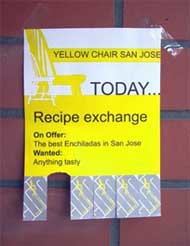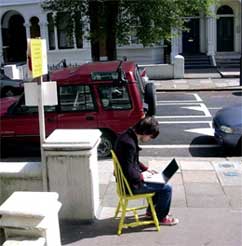Anab Jain and Tom Jenkins are to install their Yellow Chair at ISEA San Jose in August. The two designers/artists are looking for 2 households with wifi that would be interested in seeing how this might develop into a live art project for 1 week.
The yellow chair is placed on the street and advertises an open WI-FI network from which people will be able to access a ‘yellow chair’ website. When Anab first placed her yellow chair, outside her home in London last year, passersby could sit on the chair and access the shared folder on her computer with new and enticing offers or services everyday. The San Jose version will recreate this very local community space for sharing, ideas, questions, answers, recipes, music, etc, both around that chair and with another yellow chair community in another neighbourhood across town.


The project is all about how domestic wireless networks can be built upon to create a lively community space.
All of this will happen in the public space outside the house and will not interfere with your everyday life. Anab and Tom will be on hand to manage the project on a day-to-day basis, but would love to have you participate as and when you feel like it. They will cover the cost of your internet connection for the duration of the project.
I’ve always liked that project and asked Anab to tell me more about it:
Can you tell us something about the first yellow chair experience in London? Did it turn up as you expected?
Designing a service as an ongoing, live experience, without any presumptions about people’s behaviours and expectations, was a challenge.
At the start of the experience I was frustrated and ready to give up. Many people in the neighbourhood and passers-by were cynical and unfriendly. I was jokingly told by one neighbour, that because of this activity, the real estate prices of the building would crash, as no one would want to live near such crazy neighbours. However, as people began to sit on the chair and engage in conversations, the situation began to change. Over the next few days I became identified as ‘the girl with the yellow chair’. People passing by would stop to ask how I was getting on and I began to enjoy the experience. Immediate feedback from people gave me the opportunity and flexibility to constantly improvise. The idea of placing ‘offers’ attracted more people and I realised how the design of a service can grow and develop in a short span of time. Importantly, I got to know my neighbours, and met some of the people who had been ‘stealing’ my wireless network.
The service enabled people in my own flat to meet each other for the first time. Both the sign and the chair defined a ‘real world blog space’ – a territory for conversation between neighbours. People were also curious about the offers or the daily broadcasts and were keen to place their own offers in my shared folder. By designing this experience, I hoped to question the idea of ‘open networks’ being largely virtual, often impersonal and dangerous if not secured with passwords.
How do you think it would be like if you were to offer the same service in your home country, India?
The yellow chair project/service attempted to rediscover and invent informal meeting spaces for our evolving Wi-Fi landscape, inspired by the banyan tree and the tea stalls in India, which are active hubs for information exchange and transient encounters. I was hoping to create such meeting spaces through the project, and potentially create oral histories, and also reconnect the individual to this evolving environment of the physical and the electronic.
If I were to do the same project in my house, I am sure I would have a long queue of people eager to use it, unlike London, where there was a lot of skepticism. But I would perhaps have also had lot of enthusiasts who may have misused the service. I am not sure, and I trying not to make too many assumptions. However the cultural differences makes the service interesting, location-specific and a design challenge worth pursuing.
Thanks Anab, hope the chairs will find welcoming households in San Jose.
Additional note: a proposal to take the Yellow Chair Stories project into a second phase and place it in a wider context of urban life has been awarded the 3rd prize in the UNESCO Digital Art Awards competition. More about the project.
